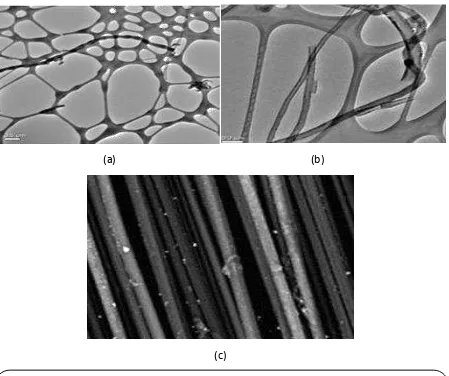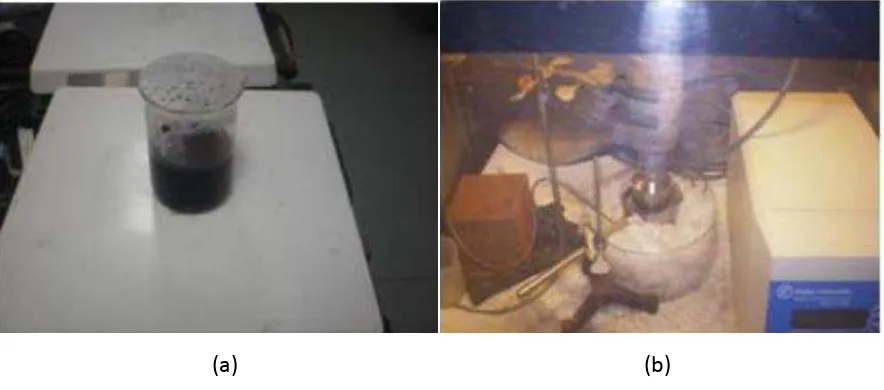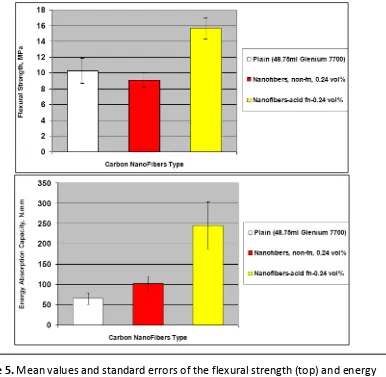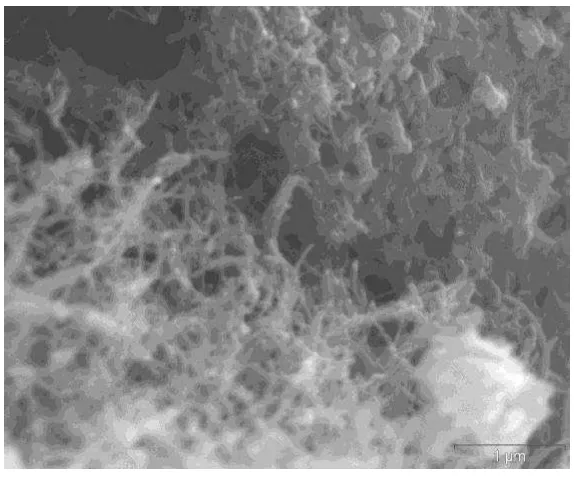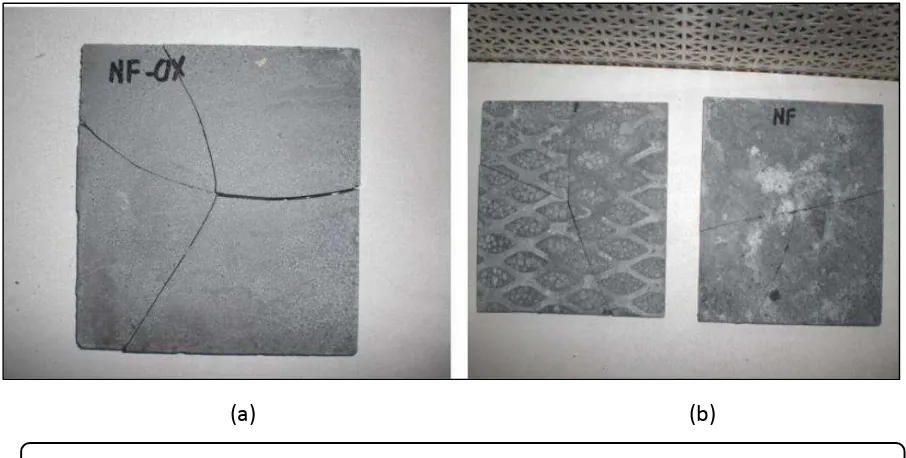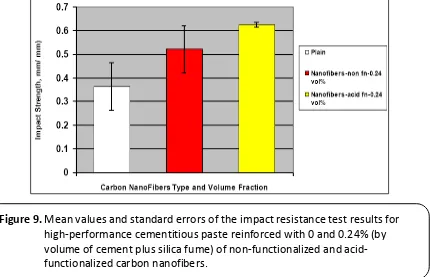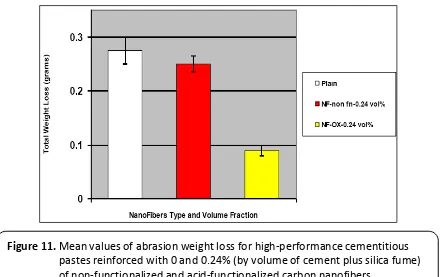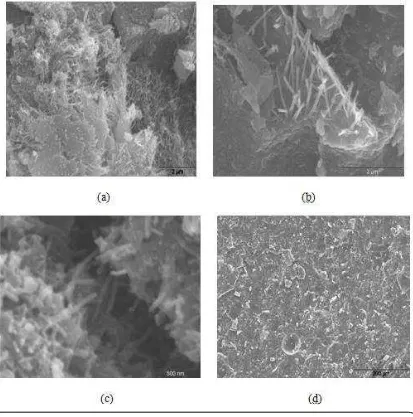High-Performance Cementitious Matrix using
Carbon Nanofibers
Muhammad Maqbool Sadiq Awan1, Parviz Soroushian2, Arshad Ali1, Muhammad Yousaf Saqid Awan
1CE Wing, Millitary College of Engineering, National University of Sciences and Technology, Islamabad 44000,
Pakistan
2Department of Civil and Environmental Engineering, Michigan State University, Engineering Building 428 S.
Shaw Lane, Room 3546 East Lansing, MI 48824, US
*Correspondence: [email protected]
A B S T R A C T S A R T I C L E I N F O
Graphite nanomaterials would realize their reinforcement potential within cement-based materials when they are thoroughly dispersed and effectively bonded to cement hydrates. Thorough dispersion of graphite nanomaterials in the fresh cementitious matrix encounters challenges associated with the hydrophobic nature of nanomaterial surfaces and their strong tendency towards agglomeration via attractive van der Waals forces. Effective interfacial interactions with cement hydrates are further challenged by the relatively inert nature of nanomaterial surfaces. An experimental program was conducted with the objective of effectively utilizing both acid-oxidized and pristine carbon nanofibers towards reinforcement of high-performance cementitious pastes. Hybrid reinforcement systems comprising optimum volume fraction of carbon nanofibers and micro-scale fibers were also evaluated in cementitious matrices. The improvements in nanofiber dispersion and interfacial interactions resulting from acid-oxidation and use of proper dispersion techniques were found to bring about significant gains in the engineering properties of high-performance cementitious materials.
© 2017 Tim Pengembang Jurnal UPI
Article History:
Received 13 January 2017 Revised 15 January 2017 Accepted 19 January 2017 Available online 01 April 2017 ____________________
Keyword:
Cementitious Nanocomposites, Carbon Nanofibers, High Performance.
Indonesian Journal of Science & Technology
DOI: http://dx.doi.org/10.17509/ijost.v2i1 p- ISSN 2528-1410 e- ISSN 2527-8045 1. INTRODUCTION
Cementitious materials are generally characterized as brittle materials with relatively low tensile strength and strain capacity, which are susceptible to early-age cracking due to restraint of shrinkage movements. (D'Ambrosia, 2012) These problems tend to be more pronounced in the case of high-performance cementitious materials with high compressive strengths. (Bui et al., 2005) Fibers (with micro-scale diameters) are incorporated into cementitious matrices to overcome these drawbacks. The micro-scale diameters and relatively low aspect (length-to-diameter) ratios of these fibers, and their viable volume fractions in cementitious materials; however, yield relatively large fiber-to-fiber spacing and relatively small specific surface area of fibers. (Peyvandi et al., 2013) These features limit the effectiveness of micro-scale fibers in controlling the flaw (microcrack) size and propagation in cementitious materials. (Peyvandi & Soroushian, 2015) Slender nanomaterials (e.g.carbon nanofibers) with nano-scale diameters and relatively high aspect ratios offer the potential to overcome these drawbacks of micro-scale fibers in cementitious materials. (Chen et al., 2011) The relatively close spacing and high specific surface area of nanomaterials provide them with the potential to effectively control the flaw size and propagation in cementitious materials. (Peyvandi & Soroushian, 2015) The close spacing of nanomaterials could also enhance the moisture barrier qualities and thus the durability characteristics of cementitious materials by forcing tortuous diffusion paths of moisture (and aggressive solutions) into cementitious materials. (Peyvandi et al., 2013)
Previous research on high-performance cementitious materials reinforced with multiwall carbon nanotubes (MWCNTs) has shown that, as far as the uniform dispersion
and effective interfacial interactions of nanotubes within cementitious paste are achieved, important gains in diverse engineering properties of cementitious materials can be realized at nanotube volume fractions in less concentration of the cementitious paste. (Sbia et al., 2015). The work reported herein examines the potential of carbon nanofibers (CNFs), which are of substantially lower cost when compared with carbon nanotubes, to bring about balanced gains in engineering properties of high-performance cementitious materials.
DOI: http://dx.doi.org/10.17509/ijost.v2i1 weight of cementitious materials on the
microstructure and mechanical properties of a cementitious matrix with 10% of cement replaced with silica fume. (Sanchez & Ince, 2009) The effects of surface treatment of CNFs with nitric acid on their reinforcement efficiency (at 0.5% by weight of cementitious materials) were also evaluated. It was found that the use of silica fume and surface treatment of CNFs facilitated their dispersion, and improved their interfacial interactions with the cementitious paste. The gains in engineering properties (splitting tensile strength and compressive strength) of cementitious matrix with introduction of carbon nanofibers were, however, insignificant. Other investigations involving microscopic observations have indicated that CNFs can control cracking in cementitious materials by bridging across fine cracks, yielding improvements in flexural strength of cementitious materials at weight fractions of about 0.048%. (Metaxa et al., 2010)
In this study, the effects of surface functionalization of carbon nanofibers (CNFs) through introduction of carboxyl groups and use of refined dispersion techniques on the reinforcement efficiency of nanotubes at different volume fractions within a high-performance cementitious (densified with small particles – DSP) matrix were evaluated. Scanning electron microscope observations of fractured surfaces pointed at successful dispersion of nanofibers within the cement-based matrix. An investigation of hybrid reinforcement systems comprising CNFs and micro-scale fibers (CMFs) indicated that selected hybrid systems offer a cost-effective approach for realizing balanced gains in performance characteristics of high-performance cementitious matrices.
2. MATERIALS AND METHODS
2.1. Materials
The carbon nanofibers (CNFs) used in this investigation had outer diameters in the 60-150 nm range, lengths ranging from 30 to μm, specific surface area of 5 -60 m2/g,
true density of ~1.95 g/cm3, and >95%
purity. They were either pristine (NF, see Figure 1a) or oxidized via acid-functionalized (NF-OX, see Figure 1b). These nanofibers were purchased from Pyrograf Products, Inc. Carbon microfibers (TT 143, obtained from Toho Tenax America, Inc.), shown in Figures 1c, were 6 mm long, with 6-7 μm diameter. Deionized (DI) water was used for all solution preparations.
2.2. Dispersion of Nanofibers in Water
The steps involved dispersion of carbon nanofibers in the mixing water of cementitious matrix. In short, first, we added the required amount of pristine or oxidized nanofibers to the mixing water. Then, we stirred the mix overnight (12 to 15 h) using a magnetic stirrer (Figure 2a). Next, the mix was sonicated using a probe as follows (Figure 2b):
1. Sonicate for ten minutes at each of the 30, 45, 65, and 75% amplitudes, with 1-minute breaks between different amplitudes;
2. Pulse (sonicate over 1 minute and rest for 30 seconds) over a period of 10 minutes at 85% amplitude;
3. Turn off the sonic probe for 2 minutes, and repeat the pulse cycle two more times;
4. Repeat steps i through iii.
DOI: http://dx.doi.org/10.17509/ijost.v2i1 p- ISSN 2528-1410 e- ISSN 2527-8045 (a) (b)
(c)
2.3. Cementitious Matrices
A dense cement-based matrix with a smooth particle size gradation covering nano- to micro-scale range was used to ensure effective interfacial interactions which help mobilize the tremendous mechanical qualities of graphite nanomaterials within cementitious nanocomposites. The high-performance cement-based matrix used here is generally referred to as densified with small particles (DSP). DSP cement-based materials
comprise micro-scale cement and nano-scale silica fume particles, dispersed and densified using superplasticizer (Figure 3). This cementitious matrix, when used with other quality ingredients (e.g., high-quality aggregates and discrete reinforcement) can yield highly desired combinations of mechanical and durability characteristics suiting demanding fields of application.
DOI: http://dx.doi.org/10.17509/ijost.v2i1
(a) (b)
The microstructure and thus engineering properties of high-performance (DSP) cementitious materials can be improved by steam or high-pressure steam curing, which benefit the pozzolanic reactions of reactive micro-scale fillers; this sub-category of DSP cementitious materials is generally referred to as reactive powder concrete (RPC).
Based on a review of the literature on DSP (and RPC) high-performance
cementitious materials, the cementitious paste matrix introduced in Table 1 was selected for evaluation of the merits of graphite nanomaterials in cement-based matrices. The materials selected for use in this high-performance (DSP) cement-based matrix include: Type I Portland cement (Lafarge-North America), undensified silica fume (Norchem, Inc.) with 200 nm average particle size, and Glenium 7700 polycarboxylate-based Type F ASTM C 494 superplasticizer (BASF).
Figure 2. Dispersion equipment: (a) Magnetic Stirer and (b) Sonication horn
DOI: http://dx.doi.org/10.17509/ijost.v2i1 p- ISSN 2528-1410 e- ISSN 2527-8045
Component Information
Silica Fume/Binder 0.20
Water/Binder 0.185
Superplasticizer/Binder Adjusted for different reinforcement
Conditions
Cementitious materials (with and without functionalized graphite nanomaterials dispersed in the mixing water) were prepared following ASTM C192 and C305 procedures. The specimens were moist-cured inside molds after casting (ASTM C 192) over a 24-hour period, and were then demolded and subjected to 48 hours of steam curing at 70oC. The samples
were subsequently conditioned at 50% relative humidity for seven days prior to testing. At least two mixes were prepared for each reinforcement condition, and at least two specimens from each mix were tested for evaluation of each engineering property.
2.4. Experimental Methods
The test procedures employed to determine the engineering properties of cement-based materials are described in this section. Compression tests (ASTM C 109) were performed on 50 mm cube specimens. Flexure tests (ASTM C 1185) were performed on 12.5x50x150 mm specimens by center-point loading on a span of 125 mm using a deflection-controlled mechanical test system, with load and deflection data collected throughout the test using a data acquisition system. Impact tests (ASTM D 7136) were performed on 12x150x150 mm specimens. These specimens were subjected to the impact of a fixed weight (with 1.5 mm in diameter tip)
dropped from heights increasing sequentially by 2.5 mm until the specimen exhibited visible cracking. Abrasion tests (ASTM C 944) were conducted on the surface of cylindrical specimens with 100 mm diameter (and 50 mm height). The into the structure and failure mechanisms of cement-based nanocomposites: (i) scanning electron microscopy (SEM); and (ii) Energy Dispersive Spectroscopy (EDS). The experimental results were subjected to statistical analysis using the analysis of variance (ANOVA) and pair-wise comparison methods. The failed surfaces of flexure and compression test specimens were evaluated under a high-precision SEM (JEOL 7500F and JEOL JM-6300F, Japan). All samples were coated with Osmium (Using Osmium Coater Neoc-AN, Meiwa Shoji, Japan) prior to SEM observations.
3. RESULTS AND DISCUSSION
3.1. Effects of Carbon Nanofiber Surface
Functionalization on Engineering
Properties
3.1.1. Flexural Performance
Typical flexural load-deflection curves for cementitious (DSP paste) matrices Tabel 1. Mix proportions of the high-performance (densified with small particles –
DOI: http://dx.doi.org/10.17509/ijost.v2i1 reinforced with 0 and 0.24% volume
fractions of acid-functionalized and non-functionalized nanofibers are shown in Figure 4. Volume fraction is calculated here with respect to the volume of cement and silica fume. The mean values of flexural strength, maximum deflection and energy
absorption capacity (area underneath the flexural load-deflection curve) are summarized in Table 2. The mean values and standard deviations of the flexural strength and energy absorption capacity test results are presented in Figure 5, respectively.
Reinforcement Condition Flexural Strength (MPa)
Maximum Deflection (mm)
Energy Absorption (N.mm)
Plain 10.30 0.40 62
Acid-functionalized nanofiber
(NF-OX), 0.24 vol.% 15.70 1.18 245
Non-functionalized nanofiber
(NF), 0.24 vol.% 9.09 0.79 102
Tabel 2. Mean values of the flexural strength, maximum deflection and energy
absorption capacity test results for high-performance cementitious pastes with 0 and 0.24% (by volume of cement plus silica fume) of non-functionalized and acid-functionalized carbon nanofibers.
DOI: http://dx.doi.org/10.17509/ijost.v2i1 p- ISSN 2528-1410 e- ISSN 2527-8045 Acid-oxidized Nanofibers produced
significant gains in the flexural strength and especially energy absorption capacity of the cementitious matrix. The improvements in flexural strength and energy absorption capacity were 52 and 296%, respectively. The relatively large length of carbon nanofibers benefits their contributions to energy absorption capacity via extended frictional pullout at cracks. The contributions of oxidized carbon nanofibers to the flexural energy absorption capacity and strength of the high-performance cementitious paste were confirmed through statistical analysis (ANOVA) of test results at 0.001 of
significance level. Non-oxidized Nanofibers produced a drop in flexural strength, although they contributed to the flexural energy absorption capacity and maximum deflection of the cementitious matrix. The drop in flexural strength can be attributed to the potential for clumping of non-functionalized nanofibers in the cementitious matrix. This observation was confirmed by SEM observations, see Figure 6. The contributions of carbon nanofibers to the flexural performance characteristics of high-performance cementitious materials are attractive, given their relatively low cost when compared with other nanomaterials. Figure 5. Mean values and standard errors of the flexural strength (top) and energy
DOI: http://dx.doi.org/10.17509/ijost.v2i1
3.1.2 Compressive Strength
The compressive strength test results (means and standard deviations) are summarized in Figure 7. The compressive strength of the high-performance cementitious matrix is observed to be either
preserved or improved with the addition of nanofibers. Analysis of variance of test results indicated that, at 0.05 significance level, the high compressive strength of the cementitious matrix was preserved after introduction of nanofibers.
Figure 6. Clumping of non-functionalized carbon nanofibers in the high-performance cementitious paste at 0.24% by volume of cement plus silica fume.
Figure 7. Mean values and standard errors of the compressive strength test results for high-performance cementitious paste reinforced with 0 and 0.24% (by volume of cement plus silica fume) of non-functionalized and
DOI: http://dx.doi.org/10.17509/ijost.v2i1 p- ISSN 2528-1410 e- ISSN 2527-8045
3.1.3 Impact Resistance
Examples of failed impact test specimens are shown in Figure 8, whereas the mean values of impact test results are presented in Figure 9. The impact resistance of cementitious materials is observed to increases with introduction of 0.24% in volume fraction of both non-functionalized and acid-functionalized Nanofibers.
The test results suggest that functionalization of nanofibers benefits their contributions to the impact resistance of the cement-based matrix. The functionalized and non-functionalized nanofibers, at 0.24% (with respect to cementitious materials), yielded about 73.6 and 44.7% gains, respectively, in impact resistance, which can be attributed to the arrest and deflection of microcracks, pullout of nanofibers, and multiple cracking phenomena in the presence of nanofibers. Cementitious materials reinforced with oxidized nanofibers exhibited more pronounced
multiple cracking as compared to those with pristine nanofibers (Figure 8).
3.1.4 Abrasion Resistance
Examples of photograph images of abrasion test specimens after performance of abrasion tests are shown in Figure 10. The abrasion test results presented in Figure 11 indicates that cementitious materials with oxidized and pristine nanofibers, 0.24% of volume fraction (with respect to the cement and silica fume volume) showed superior abrasion resistance when compared when compared with the plain cementitious matrix. The significant increase in abrasion resistance with oxidized nanofibers can be attributed to their thorough dispersion and effective interfacial interactions in the high-performance cementitious matrix. Analysis of variance of test results indicated that the contributions of nanofibers to the abrasion resistance of high-performance cementitious matrix were statistically significant at 0.05 of significance level.
(a) (b)
DOI: http://dx.doi.org/10.17509/ijost.v2i1
Figure 9. Mean values and standard errors of the impact resistance test results for high-performance cementitious paste reinforced with 0 and 0.24% (by volume of cement plus silica fume) of non-functionalized and acid-functionalized carbon nanofibers.
DOI: http://dx.doi.org/10.17509/ijost.v2i1 p- ISSN 2528-1410 e- ISSN 2527-8045
3.1.5 Scanning Electron Microscope Evaluation
The SEM images presented in Figure 12 indicate that the refined sonication and mixing steps developed in the project were successful in dispersion of individual oxidized nanofibers within the cementitious matrix at 0.24 vol% of cement and silica fume. These images also point at the low porosity of the high-performance cementitious matrix used here; the
introduction of nanofibers does not seem to have compromised the high density (low porosity) of this matrix. SEM observations verified the uniform dispersion of oxidized nanofibers; evidences of crack suppression and crack bridging were also found in all specimens examined under SEM. Oxidized nanofibers, which provided higher levels of reinforcement efficiency, were found to be more uniformly dispersed within the cementitious matrix, as some clumping was found for pristine nanofibers. Figure 11. Mean values of abrasion weight loss for high-performance cementitious
DOI: http://dx.doi.org/10.17509/ijost.v2i1
3.1.6 Energy-Dispersive Spectroscopy (EDS)
Elemental analyses were performed on 2.54x12x12 mm samples of high-performance cementitious paste with 0 and 0.24 vol% pristine and oxidized carbon nanofibers. The specimens were coated with carbon (using Carbon String Evaporator, Ernest F. Fullam) to make them more conductive for the purpose of EDS analysis. Elemental and Quantitative analyses of these samples indicated that all
cementitious materials exhibit similar elemental compositions, except for the (expected) higher carbon content in materials incorporating carbon nanofibers.
3.2. Effects of Hybrid (Nano- and Micro-Scale) Reinforcement Systems
Hybrid reinforcement systems comprising oxidized carbon nanofibers (NF-OX) and carbon fibers with micro-scale diameter (CMF) were evaluated in DSP paste. Exploratory studies of carbon Figure 12. Typical SEM images of high-performance pastes reinforced with 0.24% (by
DOI: http://dx.doi.org/10.17509/ijost.v2i1 p- ISSN 2528-1410 e- ISSN 2527-8045 nanofiber and carbon microfiber
reinforcement indicated that, for the cementitious matrix and processing conditions considered here, the nanofiber volume fraction (of cement plus silica fume) should be lowered below 0.24% before benefits can be realized from introduction of carbon microfibers. Hence, a nanofiber volume that was 0.16% that of cement plus silica fume was considered for development of hybrid reinforcement systems, which also incorporated carbon microfiber at 0.24 vol% of cement plus silica fume.
3.2.1 Flexural Performance
The flexural performance of high-performance cementitious paste was assessed following ASTM C293 - 08 Standard Test Method for Flexural Strength of Concrete (Simple Beam with Center-Point Loading), using 150x50x12.5 mm rectangular specimens. The flexural strength, maximum deflection and energy absorption capacity test results for the high-performance (DSP)
cementitious paste reinforced with different volume fractions of carbon nanofibers and microfibers are shown in Table 3 and Figure 13. Carbon nanofibers and microfibers, and especially their combination, are observed to yield important gains in the flexural strength, energy absorption capacity and maximum deflection of DSP cementitious paste. The hybrid (carbon nanofiber and microfiber) reinforcement system produced 64.9, 356, and 288% gains in the flexural strength, energy absorption capacity and maximum deflection, respectively, of DSP paste. These benefits could be attributed to the multi-scale reinforcing action of the hybrid reinforcement system. Statistical analysis (of variance) of flexure test data confirm, at 0.00 significance level, that the contributions of nano- and/or micro-scale reinforcement effects to the flexural performance of this high-performance cementitious paste are statistically significant.
Reinforcement Condition Flexural Strength (MPa) Maximum Deflection (mm) Energy Absorption (N.mm)
Plain 10.3 0.401 61.8
Carbon microfiber, 0.24% 16.1 1.13 251
Carbon nanofiber, 0.16% 14.9 1.05 213
Mixed (Carbon microfiber, 0.24% and Carbon nanofiber,
0.16%) 17.0 1.55 282
DOI: http://dx.doi.org/10.17509/ijost.v2i1 (a) (b)
(c)
3.2.2 Compressive Strength
While fiber reinforcement tends to lower the compressive strength of concrete, mainly due to the introduction of interfacial stress rise and structural defects, nano-scale (and hybrid) reinforcement systems are observed in Table 4 to produce a slight rise in the compressive strength of the high-performance cementitious paste. This
effect, however, is not statistically significant. The somewhat positive effects of nano-scale reinforcement on compressive strength could be attributed to: (i) the reduced interfacial stress concentration and structural defects due to the nano-scale dimensions and spacing of the reinforcement; and (ii) effective arrest of microcrack propagation by the closely space nanofibers.
Figure 13. Mean values and standard errors of the flexural performance attributes of the high-performance pastes with different reinforcement systems,
DOI: http://dx.doi.org/10.17509/ijost.v2i1 p- ISSN 2528-1410 e- ISSN 2527-8045
Reinforcement Condition Mean (MPa) Standard Error (MPa)
Plain 111 14.3
Carbon microfiber, 0.24 vol% 117 28.0
Carbon nanofiber, 0.16 vol% 113 17.9
Mixed ( Carbon microfiber, 0.24 vol% and Carbon
nanofiber, 0.16 vol%) 117 15.3
3.2.3 Impact Resistance
The impact resistance test results presented in Table 5 indicate that carbon microfibers, carbon nanofibers and the hybrid reinforcement systems enhance the impact resistance of DSP paste by 42.7%, 71.2, and 92.9%, respectively, which can be attributed to the arrest and deflection of microcracks by nanofibers, frictional pullout of nanofibers, the multiple cracking induced by nanofibers, and control of microcrack size by the closely spaced nanofibers. The particularly significant contribution of the hybrid reinforcement to impact resistance could be attributed to the multi-scale interaction of the nano- and micro-scale reinforcement within the matrix with microcracks. The contributions of nano- and/or micro-scale reinforcement to the impact resistance of the high-performance cementitious paste were found to be statistically significant (at 0.01 of significance level).
3.2.4 Abrasion Resistance
The abrasion test results presented in Table 6 indicate that carbon microfibers and especially hybrid reinforcement, and (to a lesser extent) carbon nanofibers enhance the abrasion resistance of the high-performance (DSP) cementitious paste. These benefits were found to be statistically significant at 0.000 significance level.
3.2.5. SEM results
Figure 14 shows SEM images which are indicative of the uniform dispersion of nanofibers within the cementitious paste (Figure 14a), and a combination of carbon fiber rupture and pullout at fracture surfaces (Figures 14b and c). The change of the morphology was found clearly.
Reinforcement Condition Impact Resistance (mm/mm)
Plain 0.365
Carbon microfiber, 0.24 vol% 0.521
Carbon nanofiber, 0.16 vol% 0.625
Mixed (Carbon microfiber, 0.24 vol% and Carbon nanofiber,
0.16 vol%) 0.704
Tabel 4. Mean values and standard errors of the compressive strength test results for high-performance cementitious paste reinforced with carbon nanofibers and/or microfibers.
Tabel 5. Mean values of the impact resistance test results for high-performance cementitious pastes with carbon nanofiber and/or microfiber
DOI: http://dx.doi.org/10.17509/ijost.v2i1
Reinforcement Condition Loss of Mass (g)
Plain 0.275
Carbon microfiber, 0.24 vol% 0.150
Carbon nanofiber, 0.16 vol% 0.250
Mixed (Carbon microfiber, 0.24 vol% and carbon nanofiber, 0.16
vol%) 0.125
(a) (b) (c)
4. CONCLUSIONS
Results of experiments conducted on cementitious pastes reinforced with non-functionalized and non-functionalized carbon nanofibers as well as their hybrids with carbon microfibers yielded the following conclusions. Acid-oxidization of carbon nanofibers benefited their dispersion and reinforcement efficiency in a high-performance cementitious matrix. The high specific surface area and the nano-scale spacing of dispersed nanofibers benefit their control of defect (microcrack) size and mitigation of microcrack growth, thus improving the nanofiber contributions to
the strength, energy absorption capacity and ductility of high-performance cementitious materials. Properly functionionalized and well-dispersed carbon nanofibers with desired interfacial interactions brought about balanced gains in the flexural strength, energy absorption and ductility, impact and abrasion resistance of high-performance cementitious paste, while preserving its high compressive strength. For the cementitious matrix and processing conditions considered in this investigation, the nanofiber volume fraction should be lowered below 0.24% before benefits can be realized from introduction of carbon microfibers. Hence, a nanofiber volume Tabel 6. Mean values and standard errors of the abrasion test results for
high-performance cementitious pastes with carbon nanofiber and/or microfiber reinforcement systems.
DOI: http://dx.doi.org/10.17509/ijost.v2i1 p- ISSN 2528-1410 e- ISSN 2527-8045 fraction of 0.16% was considered for
development of hybrid reinforcement systems. A hybrid reinforcement comprising carbon nanofibers and microfibers at 0.16 and 0.24% of the volume of cement plus silica fume produced distinct gains in the engineering properties of the high-performance cementitious paste, which could not be matched by nano- or micro-scale reinforcement used alone. This finding points at the synergistic effects offered by nano- and micro-scale reinforcement systems.
5. ACKNOWLEDGEMENTS
This project was sponsored by the National Science Foundation Grant No. IIP-1142455. The authors are thankful to Norchem, Inc and BASF Construction Chemicals for contributing materials for use in the project.
6. AUTHORS’ NOTE
The author(s) declare(s) that there is no conflict of interest regarding the publication of this article. Authors confirmed that the data and the paper are free of plagiarism.
7. REFERENCES
Bui, D. D., Hu, J., & Stroeven, P. (2005). Particle size effect on the strength of rice husk ash blended gap-graded Portland cement concrete. Cement and concrete composites, 27(3), 357-366.
Chen, S. J., Collins, F. G., Macleod, A. J. N., Pan, Z., Duan, W. H., & Wang, C. M. (2011). Carbon nanotube–cement composites: A retrospect. The IES journal part a: Civil & structural engineering, 4(4), 254-265.
D'Ambrosia, M. (2012). Early age creep and shrinkage of emerging concrete materials (Doctoral dissertation, University of Illinois at Urbana-Champaign).
Hammel, E., Tang, X., Trampert, M., Schmitt, T., Mauthner, K., Eder, A., & Pötschke, P. (2004). Carbon nanofibers for composite applications. Carbon, 42(5), 1153-1158.
Lafdi, K., Fox, W., Matzek, M., & Yildiz, E. (2008). Effect of carbon nanofiber-matrix adhesion on polymeric nanocomposite properties: Part II. Journal of nanomaterials, 2008, 5.
Lawrence, J. G., Berhan, L. M., & Nadarajah, A. (2008). Elastic properties and morphology of individual carbon nanofibers. ACS nano, 2(6), 1230-1236.
Metaxa, Z., Konsta-Gdoutos, M., & Shah, S. (2010). Carbon nanofiber-reinforced cement-based materials. Transportation research record: Journal of the transportation research board, (2142), 114-118.
Peyvandi, A., & Soroushian, P. (2015). Structural performance of dry-cast concrete nanocomposite pipes. Materials and structures, 48(1-2), 461-470.
DOI: http://dx.doi.org/10.17509/ijost.v2i1 p- ISSN 2528-1410 e- ISSN 2527-8045
Sanchez, F., & Ince, C. (2009). Microstructure and macroscopic properties of hybrid carbon nanofiber/silica fume cement composites. Composites science and technology, 69(7), 1310-1318.
Sbia, L. A., Peyvandi, A., Soroushian, P., Balachandra, A. M., & Sobolev, K. (2015). Evaluation of modified-graphite nanomaterials in concrete nanocomposite based on packing density principles. Construction and building materials, 76, 413-422.
Shofner, M. L., Lozano, K., Rodríguez‐Macías, F. J., & Barrera, E. V. (2003). Nanofiber‐ reinforced polymers prepared by fused deposition modeling. Journal of applied polymer science, 89(11), 3081-3090.
